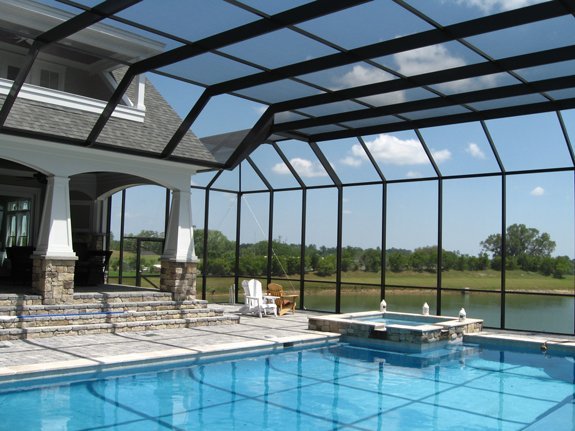If you’re wondering how much are pool screen enclosures, you’re not alone. It’s one of the most common questions homeowners ask when planning to upgrade their pool area. Whether you’re building from scratch or considering an upgrade, screen enclosures offer a mix of aesthetics, functionality, and safety. But just like any other home improvement project, costs can vary widely depending on several factors.
Let’s dive into everything you need to know to make an informed decision, from pricing to materials to installation options.
What Influences the Cost of Screen Pool Enclosures?
There are several variables that influence how much you might spend on screen pool enclosures. Understanding these can help you budget better and avoid surprises down the road.
One of the biggest cost drivers is size. Naturally, the larger your pool and surrounding area, the more materials you’ll need, and the more complex the installation. A small enclosure may cost around $6,000 to $8,000, while larger, custom-designed structures can easily reach $30,000 or more.
Next is the type of screen used. Basic fiberglass screens are affordable and popular, but you’ll also find upgraded options like pet-resistant mesh, solar screens, or privacy screens. Each of these adds unique benefits—but also affects the total price.
Then there’s the structure itself. Aluminum framing is most commonly used for its strength and rust resistance, but higher-end designs or powder-coated finishes will increase costs of screen pool enclosures.
And don’t forget labor! Depending on your region, installation costs can vary. Urban areas with higher demand and labor costs will likely be on the pricier end of the spectrum.
Types of Pool Screen Enclosures
Different pool screen enclosure styles serve different needs, and the one you choose will greatly affect your final cost.
- Standard Screen Enclosure: This is the basic, no-frills option. It provides bug protection, sun filtering, and a defined space around your pool. Costs generally range from $6,000 to $12,000 depending on size.
- Dome or Mansard Style Enclosure: These are more visually appealing and offer greater headroom. Because of their height and more complex design, they usually cost more—expect to pay $10,000 to $20,000.
- Two-Story Enclosure: Got a second-floor balcony or just love big open space? Two-story screened pool enclosures provide luxury and space, but they also come with a hefty price tag—typically $20,000 to $50,000.
- Retractable Screen Enclosures: Want the flexibility to open and close your enclosure depending on the weather? Retractable options are available but usually require a higher upfront investment.
No matter which type you go with, always get a professional inspection and quote. It ensures your enclosure will be both safe and up to code.
How Much Are Pool Screen Enclosures: Material Matters
Materials play a huge role in determining cost and answer the question: how much are pool screen enclosures. Cheaper materials might save money upfront but could require more maintenance or faster replacement.
Screening Material Options:
- Fiberglass: The most common and budget-friendly.
- Aluminum: Stronger and longer-lasting, but more expensive.
- Pet-Resistant Mesh: Great if you have pets, though it adds to your budget.
- Solar Screen: Helps block UV rays and lower pool water temperature.
- Privacy Screen: Offers visual privacy but may reduce airflow and light.
Frame Material:
- Aluminum Frames: These are rust-resistant and ideal for humid climates.
- Steel or Wood: Rarely used due to higher maintenance and corrosion.
When choosing materials, think long-term. The right investment now could save you hundreds—or even thousands—down the line.
Installation and Labor Costs: Drivers of Pool Screen Enclosure Cost
Labor costs are another major piece of the pool screen enclosure cost. If you’re handy and considering screen enclosure kits for pools, that could reduce labor fees. But keep in mind, DIY options often take longer and require precision.
Professional installation is recommended for most homeowners. Depending on the complexity and your region, labor can make up 30-50% of the total project cost. Installers often handle permits, foundation work, and custom measurements.
To avoid surprises, always request a detailed quote that includes both materials and labor. Some contractors offer packages that bundle the whole process, which can be more economical. If you are interested, check our services.
Additional Costs You Should Know About
Beyond materials and labor, several extra costs may come into play:
- Permits: Many local governments require permits for pool enclosures.
- Foundation or Decking Work: Sometimes, the base needs leveling or reinforcement.
- Maintenance: Annual upkeep can include cleaning, screen replacements, or structural inspections.
- Custom Features: Things like lighting, ceiling fans, or decorative trims can bump up the price.
By accounting for these from the start, you’ll set more realistic expectations and avoid sticker shock later.
Why a Screened In Pool Enclosure Is Worth It
Even though the price tag can seem steep, a screened in pool enclosure offers major benefits. First, it dramatically reduces the amount of debris, bugs, and pests entering your pool area, which means less cleaning and more enjoyment.
Second, it extends the life of your pool equipment by protecting it from sun exposure and environmental wear and tear. Third, it creates a safe environment for kids and pets, giving you peace of mind. And finally, it adds value to your property—many buyers consider a screen enclosure a premium feature.
So yes, screened in pool enclosure costs money—but they also bring a return in quality of life and property value.
Final Thoughts: So, How Much Are Pool Screen Enclosures Really?
To wrap it up, how much are pool screen enclosures depends on your specific choices. A basic, small enclosure might run around $6,000, while a large, custom two-story version with premium screens could be closer to $30,000 or more. Your location, the materials you choose, and the complexity of the installation will all influence that final number.
The key is to think about your long-term goals. Are you just looking for bug protection, or do you want to create a full outdoor living experience? By being honest about your needs and doing a little research, you can find an option that fits both your budget and your lifestyle. Are you looking for prices, contact us now.


